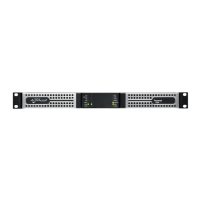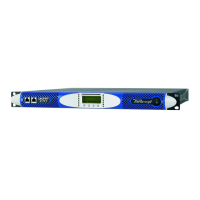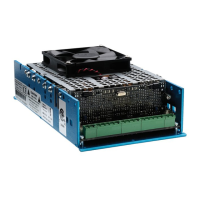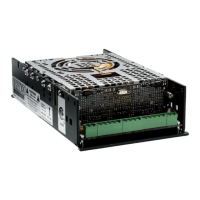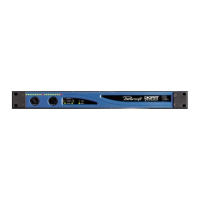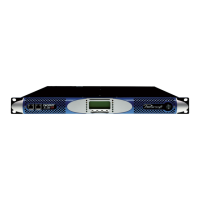▶
21
Duecanali User Guide
in the IN1 (analog) and IN2 (set to analog) plugs. The amplier’s
source selection can be set to any possible input. If the AES3 feed
should fail, the amplier will automatically fall back to the analog
input on the CH1 and CH2 plugs. The signal levels of both primary
AES3 and backup analog signals should be carefully matched so
they are identical. This can be done using the Gain trim parameter
or by adjusting the analog signal level.
Analog back up cabling
(carrying the same signal as the
CH1 of the AES3 feed)
IN1
IN2
CH1 out
CH2 out
Analog back up cabling
(carrying the same signal as the
CH2 of the AES3 feed)
Main digital AES3 stream via RJ-45
CH1
CH2
main digital connection
analog backup connection
(used if digital fails)
FIGURE 36: Analog back up mode connection: in this example, the
amplier is set to output the AES3 stream in stereo mode. Other
congurations of the amplier mode are possible.
When the AES3 stream is lost and the analog backup kicks in, a
message on the front panel is displayed and an alarm is sent to the
remote client if one is connected to the amplier.
8.2.1.5 Cross Limit
In case of power limiting of only one channel, (see “Limiters” on
page 23) the gain reduction on one channel is mirrored to the
other channel in order to maintain consistent levels. This is useful
in two ways speakers where the limitation of one channel alone
leads to an unbalanced sound. This function can be turned on or
off.
8.2.1.6 Sound speed (m/s)
This menu allows the user to set the sound velocity used for time
to distance conversions throughout the local interface. It can be
set from 320 m/s to 360 m/s.
8.2.2 Channel Settings
All of the following settings are available for both channel 1 and
channel 2. In all the following menus and submenus, the channel
number whose properties are being edited is shown in the top
right hand corner of the menu. If a specic parameter affects both
channels, the top right hand corner will report this as “1+2”.
8.2.2.1 EQs
This menu gives access to the parametric output equalizer input
interface. This menu lists the 16 parametric lters one by one.
The current selected lter number is shown on the left of the rst
line. By pressing the up and down pointing arrows, it is possible
to move from one lter to the next. The lter parameters are
reported on the screen.
8.2.1 Common Settings
8.2.1.1 Source Selection
This menu allows to choose the input signal to be processed by
the DSP. The possible options are:
▶
Stereo: the signal coming from channel 1 is processed and
routed out to output channel 1. Similarly, the input signal
coming from Channel 2 is processed and then routed out to
output channel 2.
▶
Parallel from CH1: the input signal from channel 1 feeds two
parallel, distinct and independent processing branches. The
result of one branch is sent to output channel 1, while the
result of the other branch is sent to output channel 2.
▶
Parallel from CH2: the input signal from channel 2 feeds two
parallel, distinct and independent processing branches. The
result of one branch is sent to output channel 1, while the
result of the other branch is sent to output channel 2.
▶
Mono Mix: the input signals from channel 1 and 2 are
summed together and divided by two in order to maintain a
consistent output level. This mono mix signal is fed to both
output channels.
8.2.1.2 AES3
This menu controls the AES3 input stream options. The AES3
source can enter the amplier from the rear Phoenix (both AES3
input or AES3 aux) or from the KAESOP board (if present) based
on the type of input selection (see “7.3 Input select” on page
18).
8.2.1.3 Gain trim (dB)
This menu allows the user to set the gain to be applied to the
signal coming from the AES3 digital input. Setting a 0dB gain makes
the full-scale digital signal equivalent to an analog input signal of
20dBu.
8.2.1.4 If no link
This menu controls the amplier’s behavior should the AES3 signal
from the rear “AES/EBU main input” connection fail or become
unreliable. The AES3 connection is considered unreliable when
transmission errors are greater than 1% of total data transmitted.
The possible options are:
▶
Mute: when the AES3 connection fails, the amplier mutes
the output.
▶
Analog: when the AES3 connection fails, the amplier will rely
on the analog input as backup. This source signal switching is
done in real time in order to avoid any glitches in the audio
feed. If the input levels are correctly matched between analog
input and AES3 input (use the AES3 Gain trim parameter),
the switch between AES3 and analog will be inaudible.
When using the analog input to backup a failed AES3 feed, the
analog input connection must be setup based on source type of
input AES3 stream:
AES3 from KASEOP:
the primary audio signal for this amplier conguration is an AES3
signal, fed via an Ethernet port. The backup analog cable, with an
analog signal identical to that provided by AES3, should be plugged
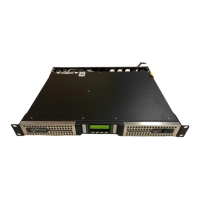
